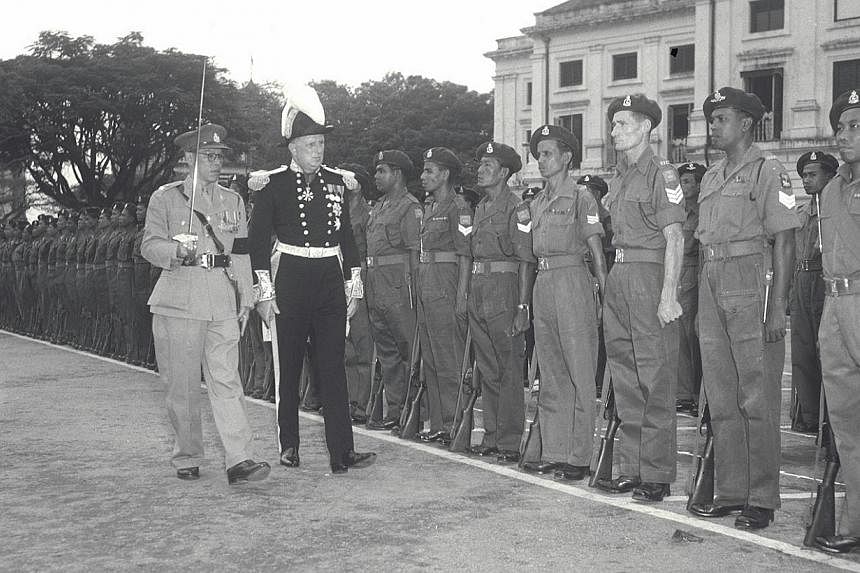SINGAPORE - Singapore's first president Yusof Ishak was in it. So were first Defence Minister Goh Keng Swee and war heroine Elizabeth Choy. The Singapore Volunteer Corps (SVC), that is.
The contributions of the militia group will be celebrated this year as the country and Singapore Armed Forces (SAF) turn 50, Defence Minister Ng Eng Hen said in Parliament on Thursday.
The Ministry of Defence is also reviving the volunteer unit as the SAF Volunteer Corps, which will see its first batch of 30 to 50 recruits in March.
They will be continuing a tradition that is 161 years old. Here are some milestones and significant contributions made by the unit.
1. How the Corps started
The SVC was one of the oldest volunteer forces in the British Empire.
Bloody clashes between rival Hokkien and Teochew gangs that killed more than 400 people led to the formation of the first volunteer corps in Singapore.
There were 61 European expatriates in the Singapore Volunteer Rifle Corps (SVRC) set up in 1854, and they had to provide their own firearms. The SVRC dwindled in the 1880s and 1890s as Singapore became more peaceful.
In 1901, it was renamed the Singapore Volunteer Corps, and Chinese and Malay regiments were added in the early 1900s.
The enlargement of the Corps was partly due to World War I, but it proved timely as the Sepoy mutiny broke out in 1915. The volunteer soldiers helped to implement martial law, and fought alongside regular soldiers.
In 1922, the SVC joined the Straits Settlements Volunteer Force (SSVF), which included volunteers from other Malay states.
2. Drill Hall
The Drill Hall at Beach Road was the headquarters of the Singapore Volunteer Corps. The complex was built in the 1930s, and was often used as the mobilisation centre for volunteers.
It stood in as the headquarters for the Singapore military in the 1950s before new facilities were built. The site has been sold and will be developed as a commercial property- South Beach, but the existing buildings, including the SVC headquarters will be conserved.
3. World War II
During the Japanese invasion of Singapore, the volunteers protected vital installations, including machine gun bunkers and artillery emplacements for the seaward defence of Singapore's southern coast.
Choy served as a second lieutenant in the women's auxiliary arm, and was given the nickname "Gunner Choy".
They suffered heavy casualties in the battle for Singapore from Dec 8 to 15. After the surrender, many were interned as prisoners-of-war, and died in captivity, or at the hands of the Kempeitai. Some were sent to work on the Death Railway in Thailand.
After the occupation ended in 1945, the Singapore contingent of the SSVF was disbanded, but a group of former volunteers revived it in 1949.
4. Konfrontasi
The Indonesia-Malaysia confrontation was started by Indonesian President Sukarno to oppose the formation of Malaysia. Known as Konfrontasi, it spanned three years, from 1963 to 1966.
Those three years were marked by armed incursions, bomb attacks, and acts of subversion, notably the bombing of MacDonald House in Mar 1965.
Singapore then had only two regular army units and they were deployed in Malaysia. The defence of Singapore was entrusted to the Singapore Volunteer Corps and the Vigilante Corps, established in 1964. In two months, more than 10,000 people volunteered.
They protected vital infrastructure such as the oil installations on the Southern islands, Kallang Gas Works and water filtration plants.
5. People's Defence Force
After separation in 1965, Singapore found itself without an army overnight. Singapore's military consisted of the First and Second Singapore Infantry Regiment (1 and 2 SIR), and the Corps, which was renamed the People's Defence Force (PDF).
A recruitment exercise was held in December to boost its ranks, and more than 3,000 volunteers signed up. They were put through crash training programmes.
When National Service was instituted in 1967, the need for volunteer soldiers diminished, and membership in the PDF fell. But the volunteers formed a vital kernel of SAF personnel.
Experienced volunteer officers were absorbed into the regular army to help in the establishment of the new SAF. Many of the early directors of the Singapore Armed Forces Training Institute (SAFTI) had volunteer backgrounds.
The last volunteer unit, the 101 Battalion, was disbanded in 1984.
Sources: The Straits Times, National Library Board, Singapore Armed Forces (1981), Policing Singapore in the 19th & 20th centuries (2002), Ministry of Defence website

